
Cinema Product Reviews

Strong Platter (Phase Control)
Manufacturer: Strong International
Grade: C
Reviewed January 2003 by Joe Redifer
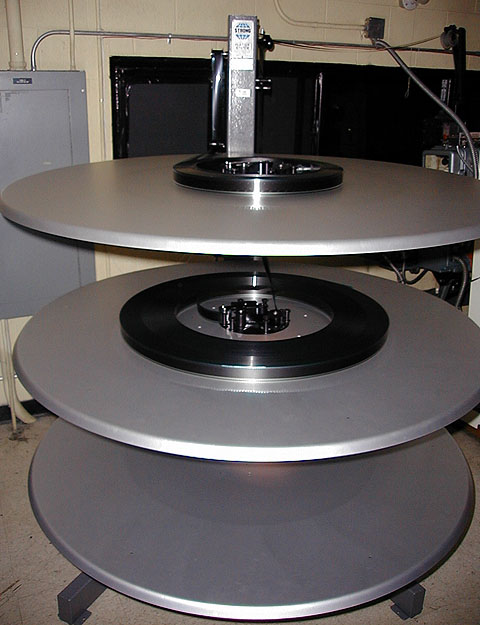
Strong offers three types of A3 platter system; Microswitch, Phase Control,
and SCDC (digital control). They all have similarities and they all have
differences. I will be reviewing the Phase Control A3, which is Strong's
mid-grade version of their platter system. This platter has a switch on
each deck for Payout, Rewind, Makeup, and Off. I rarely if ever have it
switched to Off. Strong also offers the AP3, which is a switchless version
of this platter system. Oh how I wish I had that. But other than the absence
of switches, everything is exactly the same on the AP3 as it is on the
A3.
The Strong A3/AP3 Phase Control offers 3 or 5 decks. Here we are looking
at the 3 deck version since that is what most theaters will use. The decks
are thin silver colored aluminum driven by vacuum cleaner motors. Vacuum
cleaner motors? Yup. Amazingly Strong has made several improvements over
time and these motors are virtually silent most of the time. I like that.
And when your booth floor is dirty and you blow up your vacuum cleaner
trying to clean it, you can always just swipe a motor from an unused deck
to finish sucking up those rat droppings!
The Strong Phase Control uses an LED inside the brain/payout which is
installed over a photocell. As the payout arm moves, the LED light is revealed
more and more to the photocell and the platter spins faster and faster.
Unfortunately the payout speed is still controlled by the takeup variac
(pictured below). The payout is allowed to run a bit faster than the takeup
is running so it can undo minor wraps and the such.
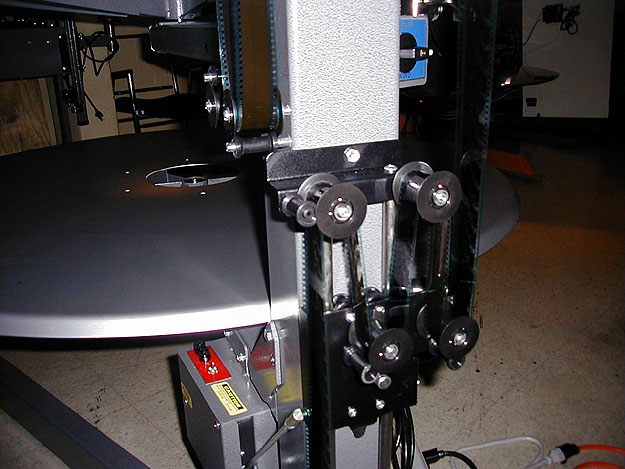
The Strong Phase Control platter system feeds out incredibly smooth
when all is well. I have been fooled on several occasions into thinking
the platter was not running since it seemed like it was standing still
and the motors were so quiet. Now that's SMOOOOOOTH payout! Very
impressive. But if even one motor gets slightly slower or faster (or even
bumped into by the operator) this will affect the timing of all three decks,
due to the variac controlled speed. The platter is timed by physically
moving the motors closer and further from the spinning deck. Timing these
things is not what I would call "good times".
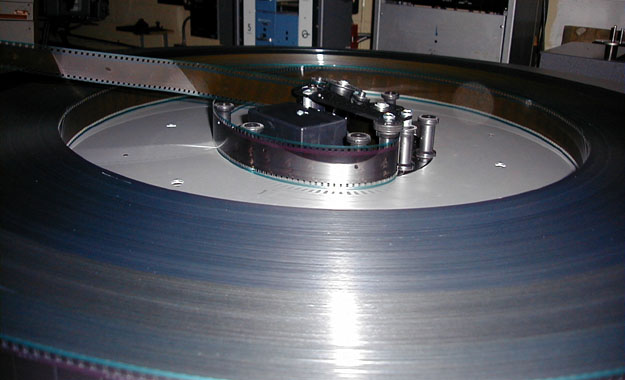
Even under ideal circumstances the timing does not stay consistent with
the phase controls. It seems to drift over the course of a few days, and
these are brand new units. It begins to drag around the brain, as seen
in the Pulitzer Prize winning picture above. This is probably not cause
for concern, but it makes me feel as if I have purchased a cheap microswitch
platter. But it's not quite that bad, as once it drags it just usually
keeps dragging in the same place. Every once in awhile I will see a unit
going back and forth like a bad microswitch platter. More thought could
go into the design of the payout, that's for sure.
You may be asking "Can I mount my film cleaner on this platter
since it is the preferred place for it? It's soooo much easier to deal
with the film cleaner when it is on the platter and upside down. Well can
I mount my cleaner there, huh?"
Unfortunately the Strong platter does not have any threaded inserts
to mount a film cleaner bracket. You can always drill and tap your own,
but it really would be nice if they came from the factory like this. In
fact I'd raise the grade in this review a notch if they did. However with
the lack of sufficient payout tension you might not get a good cleaning
anyway (see below) without modifying your Strong brains.
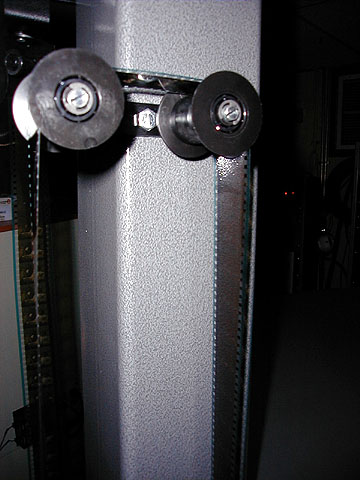
Take a look at these two rollers. Believe it or not, each roller on
the platter can spin clockwise AND counter-clockwise, though not simultaneously.
Normally you thread over just the first one on the left, but if you are
taking up onto the top deck, you must thread over both of them. Not really
a complaint, but an observation. I do think it could be designed a bit
more thoughtfully in this area, but no huge deal. But I also show this
to get a close up of the rollers. Yes, every single roller in this platter
system is tiny and powered by ball bearings. This not only results in more
stress on the film in certain areas, but also makes a film cleaner a bit
less effective since there is not much tension on it once the film gets
there.
And then there is the brain/payout.
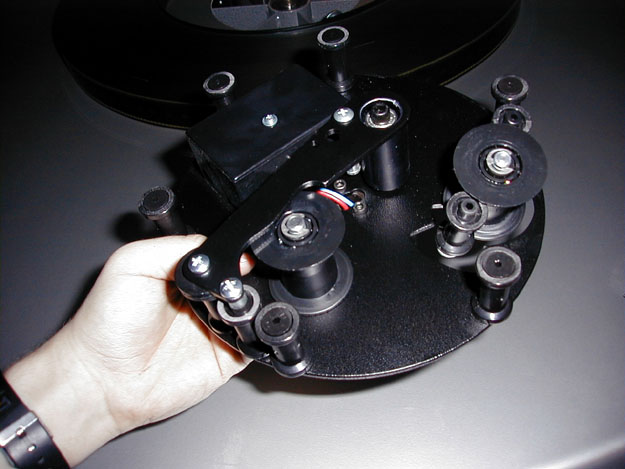
It is easily removable. It has lots of rollers around it. Why? Because
Strong knows that their platters tend to drag on payout, and the rollers
are there to protect the film from getting scratched and to delay brainwraps.
Brainwraps can get well over 50 layers of film thick before the film gets
too hard for the projector to pull. Is that a good or a bad thing? You
decide. Personally I don't like it. Strong offers a wrap detector which
does add some tension and is beneficial if you have a projector mounted
film cleaner. The wrap detector allows about 15 to 20 wraps around the
brain before it triggers the switch in the variac and the platter shuts
down. You can also lock the wrap detector "open" so that it won't stop
the platter if you want.
At least Strong has taken the metal bracket off of the top of the tri-rollers
that feed directly out to the rollers on the platter tree. This metal bracket
is now underneath. It is now much easier to thread. But Strong still has
the payout arm upside down. There is no reason for this. You must push
the film through the rollers when threading, which is a pain, especially
when you need to get the film threaded NOW! It also makes it a pain to
try and unthread the film if there is a need. Ideally you should be able
to drop the film in and pull it out of the payout arm the same way you
would on a Christie brain. I have heard that the Strong engineers and designers
actually considered making this change, but did not implement it as "they
did not like the reason for the change" or something along those lines.
So let me get this straight. They understand the reason to move the bracket
covering the takeoff rollers on the brain, but they don't understand the
reason to make the payout arm upside down from the way it is now? Guess
what... the reason for both is the same! Do they think the film will just
magically float out of the brain if it is not covered? Is there some issue
that we do not know about with their platters that actually tries to pull
the film STRAIGHT UP out of the brain? The film seems to stay in the takeoff
rollers pretty well, so why not the payout arm? It is obvious that the
designers of this platter do not have to use it day after day, otherwise
I'm sure things would change. Interestingly, I have modified my Strong
brains so that I can thread by just dropping the film in from above, and
it can come out easily if I want it to as well. There have been NO adverse
affects to this, the film stays in the brain, the brain runs great, and
everyone loves it much more. In fact I had someone from another theater
touring my booth not too long ago. He saw my modified brains and actually
got ANGRY that the ones on his Strong platters were not like this.
Then there is the ring.
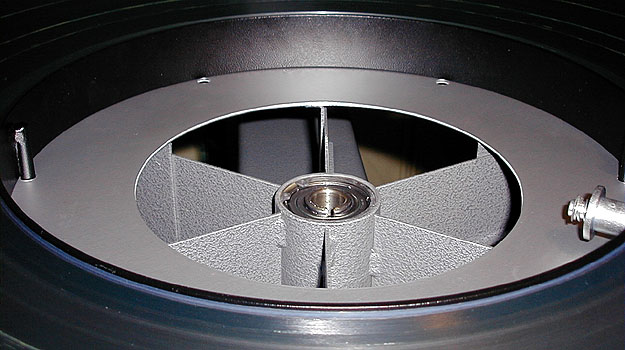
It easily collapses so you can remove it. It also grows back to its
full, firm size with a quick tug of both hands. There are many exciting
holes to choose from when you go to put it in, unlike only two holes on
other platter systems. You'll get it in quick and you'll never complain
about not being able to find the hole. Unfortunately it is also a bit flimsy.
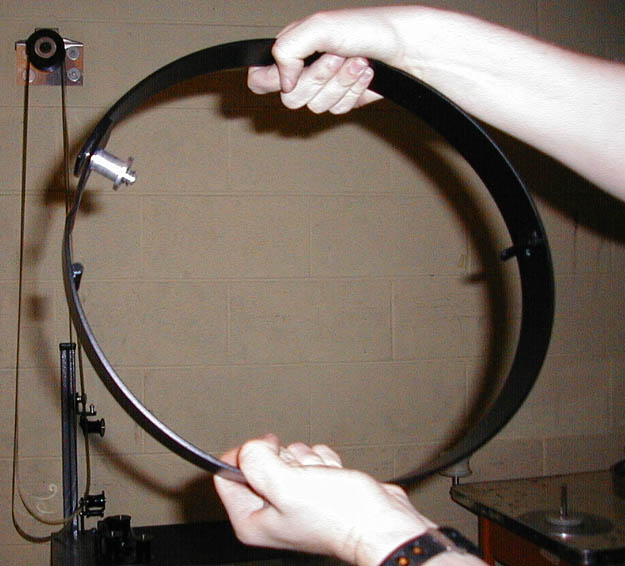
Check out how easily the ring is bent. It is so thin. Another gripe
would be the pathetic diameter of the ring... it is way too small! Fortunately
Strong sells a larger diameter ring, but it should be included as standard
and the small ring should be available only upon request, though I'm not
sure why anyone would want the smaller ring. One last minor gripe about
the ring is that it has such a tiny notch to tuck the film into. In fact
I must put a thin spacer washer in the ring just to make the gap big enough
to tuck my leader into. Many people like to use friction and wrap the leader
round and round the ring. This does not seem to work well on these newer,
textured Strong rings for some reason. Not sure why. I tuck anyway.
Be careful about removing the brain when doing any kind of trailer
work! When you take out the brain, a big, gaping hole is revealed. This
hole is here so that film can accidentally fall through. And keep falling
and falling either onto a platter below or onto the floor. The picture
below is an example of this (yes, the leader was actually falling when
the pic was taken, but the flash on the camera makes it look like it isn't
moving very fast). Once this happens to you, you will wonder why Strong
didn't design the decks themselves a bit differently. This is one hole
you do not wish to enter.
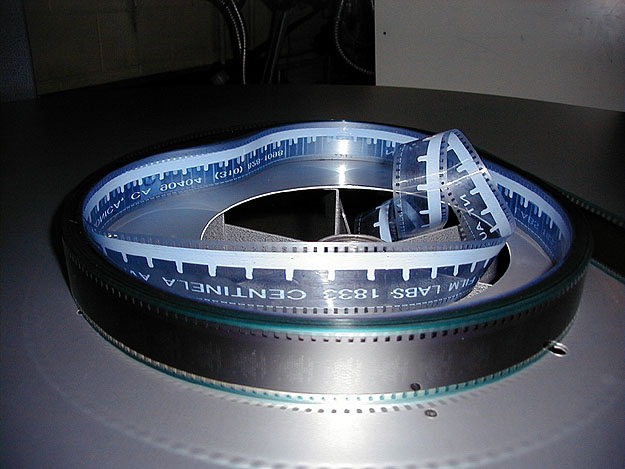
Finally we have the MUT (Make Up Table).
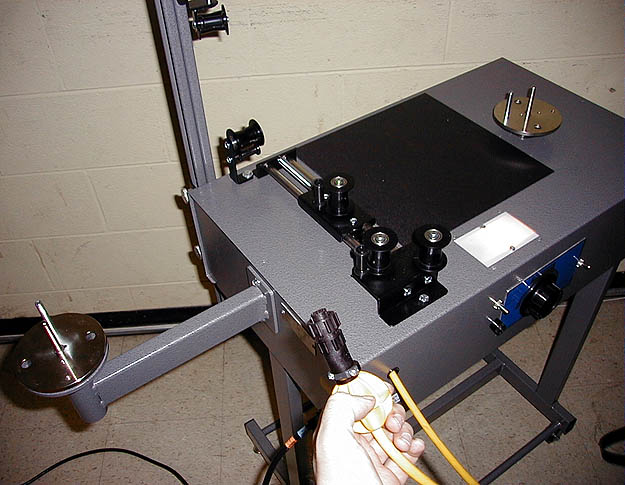
It's a horizontal design so you want to make sure your film doesn't
come too close or go over the rim of the reels you put on it. Otherwise
you will need four hands to keep the film from falling onto the floor.
The MUTs have three speeds. Slow, Supa-Fast, and Obliteratingly Fast. If
you are not careful film can be damaged with this thing! It does wrap film
pretty tight onto the reels when breaking down, I find. I like that.
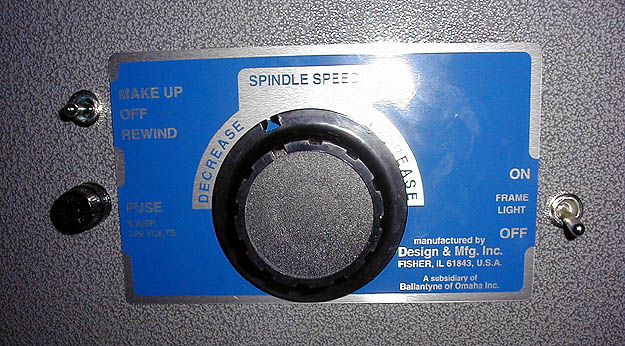
It does move around quite easily however. It also feels pretty sturdy.
It has a nice light that can not only be switched on, but it can actually
be switched off as well. But there are two more gripes. First there is
no place to put a splicer when you are breaking down a film. Very annoying.
There should be a snap-up table on the right side or something. This proves
that Strong's engineers do not actually work with the equipment that they
design. Second the unit requires you to hook a cable up to the platter
and also plug it into the wall. It cannot derive its power from the platter
like a Christie MUT can. I know some people actually like this feature
because it enables them to use the MUT as a rewind bench. That's cool.
But I offer this solution: Make it powered by the cord when connected to
the platter just like a Christie MUT. That way there is only one cable
to worry about. When one desires to use the MUT as a rewind bench, plug
in the detachable cord into the wall for "auxiliary" power. I think this
would satisfy my gripes yet still satisfy those people who need it as a
rewind bench. I just cannot stand having TWO cords to worry about when
I load up a print. And the black power cord has many kinks and does not
lay smoothly on the floor. It is a pain to deal with. Third (yes, I know
I said only two more gripes, but I lied) the spindles to no have a lock
key on them. That means you can't put a flat trailer flange on the MUT
and expect to work with it. You're screwed. There is a simple modification
for this, but it should still come with a keyed spindle nonetheless. And
guess what? The MUTs are designed and manufactured by Design & Mfg.
Inc. They don't do anything EXCEPT design and manufacture. But I think
that the Strong MUT should be sent over to Redesign & Mfg. Inc. If
they handled it we'd see some nice improvements.
Oh. And one more very, very important detail. Each platter deck
has basically what amounts to "fan blades" as support, as seen in the pictures
below. If the top deck is spinning and you lean in to try to change a trailer
on the print that is on the middle deck, you can become painfully injured
by getting hit in the head with one of these spinning blades. You will
not be enjoying yourself OR these platters if that happens. Also, you cannot
break down a print that is sitting above another print that is paying out.
Check out the pictures below to see what happens to the film feeding out
if you try:
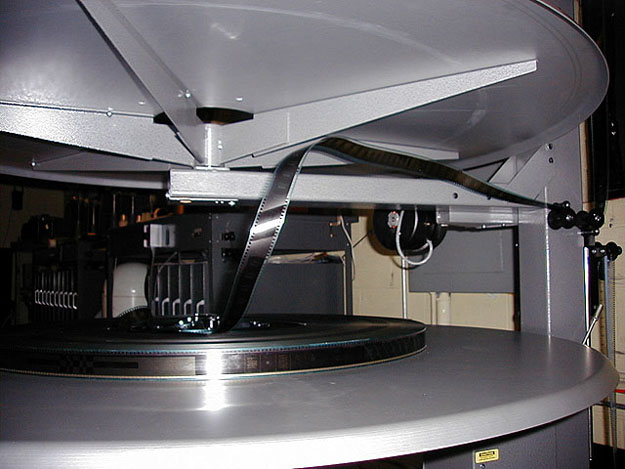
Yup. The fan blades make sure your film flies all over the place! These
pictures were taken with a flash and because of that they look "still".
This is one of many details about the platter that show that the designers
know nothing about real world projection room conditions. And even another
picture:
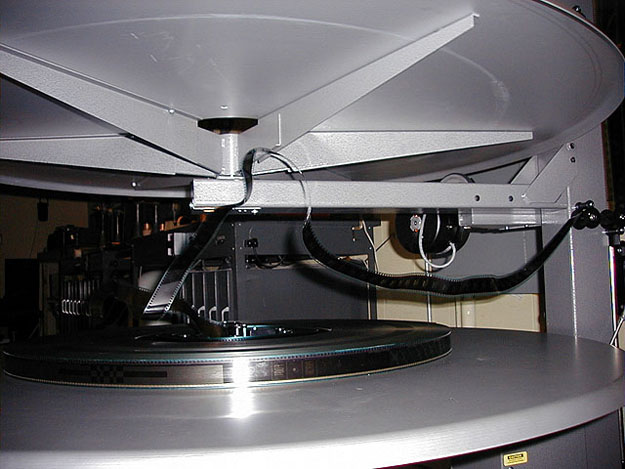
Nothing but good times! In order to be able to break down a print and
not have the film that is feeding out do this, you must have the speed
dial on the MUT set very, very low. Oh, and check out the onscreen result
of the film that was feeding out:
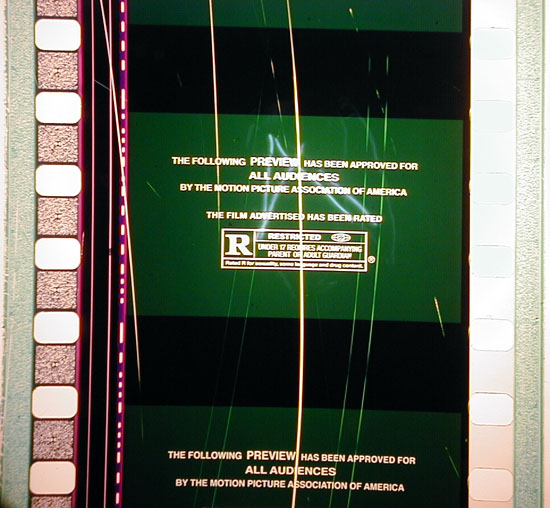
This is the green band of the trailer that was feeding out when the
above pictures were taken. This was not modified in any way, and there
is no photographic trickery going on. The only thing that should be noted
is that the blue lines are from the light underneath the film, and are
not scratches themselves.
Bottom Line: Cheaper is not always better. There are definitely better
platters out there, and there are definitely worse as well.
--Joe Redifer
Strong International can be contacted at www.ballantyne-omaha.com
Joe Redifer has been a projectionist for the several years. He
learned at Mann Kipling, went on to the UA Greenwood, spent 2 years at
Mann Chinese and is currently working at an art venue.
The views contained herein do not necessarily reflect
the views of the publishers of this website. The published views
express actual testimony to personal use of particular products or services.
The testimonies, good or bad, are based on fact and thereby releases any
and all people of any slanderous liability including the author.
Anyone who views this portion of the website must accept these views as
statements of the author of that opinion based on actual use of the product
and/or service.













